Aging and Aviation:
How Airports and Airlines Will Need to Adapt
Written by: Lisa Schafer, Jordan Roos, and Rich Barone with contributions from David Billiter
With the 2020 United States (U.S.) census estimating there are approximately 73 million baby boomers in the US1, an estimated 10,000 baby boomers will hit retirement-age every day for the next 12 years. Globally, two billion persons will be 60 years of age or more by the year 20502. As retirement age approaches, people are more prone to health issues, such as mobility impairment. However, baby boomers are exploring the world at higher rates. As the number of aging passengers in the travel industry continues to rise, airports and airlines will face challenges in providing necessary accommodations for this disadvantaged group of travelers.
This brief provides a broad understanding of the aging population and the impact it has on the airport and airline industry. Airports and airlines must be prepared to provide equitable accommodations to this growing population, while maintaining an optimum level of service (LOS), including creating a well-balanced amount of comfort for aging passengers and efficiency of the airport.
Baby Boomer Generation
Born after World War II, from 1946 to 1964, baby boomers make up the second largest age-cohort in the U.S. By 2035, over 21% of the U.S. population will be over the age of 65 – as illustrated in the graph.3
This demographic is expected to grow 72% from 2000 to 2035. Other countries, such as South Korea and Japan, have even higher life expectancy. Coupled with lower birth rates, aging adults are projected to outnumber children under the age of 18 for the first time in U.S. history by 2034.4 With these lower birth rates, comes a great responsibility on younger generations to take care of the increasingly aging population that outnumber younger generations.
Noted in the graph, the average life expectancy at the age of 60 years old for countries with the highest number of airline passengers. Roughly, two-thirds of these countries depict above-average life expectancy compared to the rest of world.5 The post-retirement experience of baby boomers is unlike other generations due to rapid globalization, medical advancements, healthcare reformation, and unfortunately, the increased presence of chronic diseases. Many will develop chronic diseases causing mental and mobility impairments and will require unique accommodations and solutions, particularly for the travel industry. Baby boomers are expected to represent a large sector of the leisure travelers for the airlines, but they also represent a growing generation that is more accepting of the medical tourism industry.6
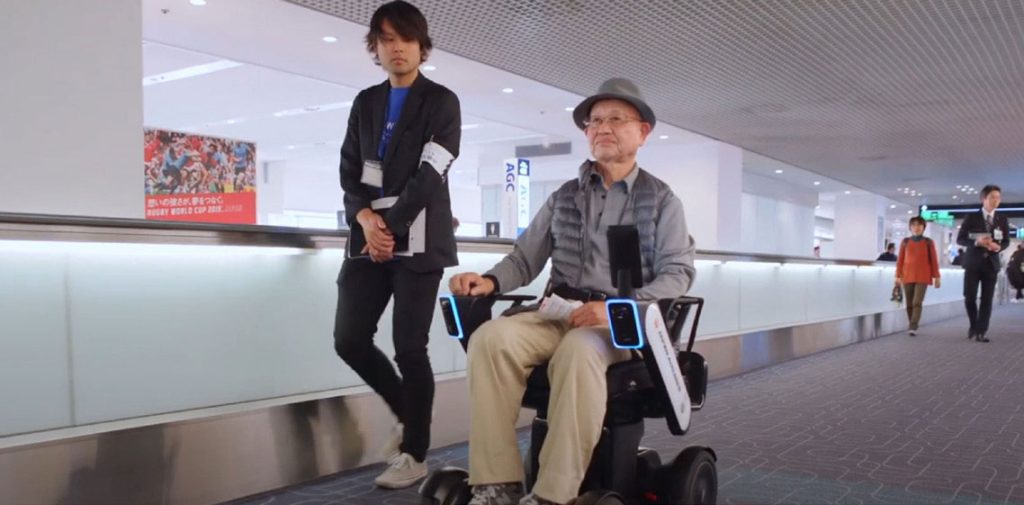
Source: WHILL, 2019.
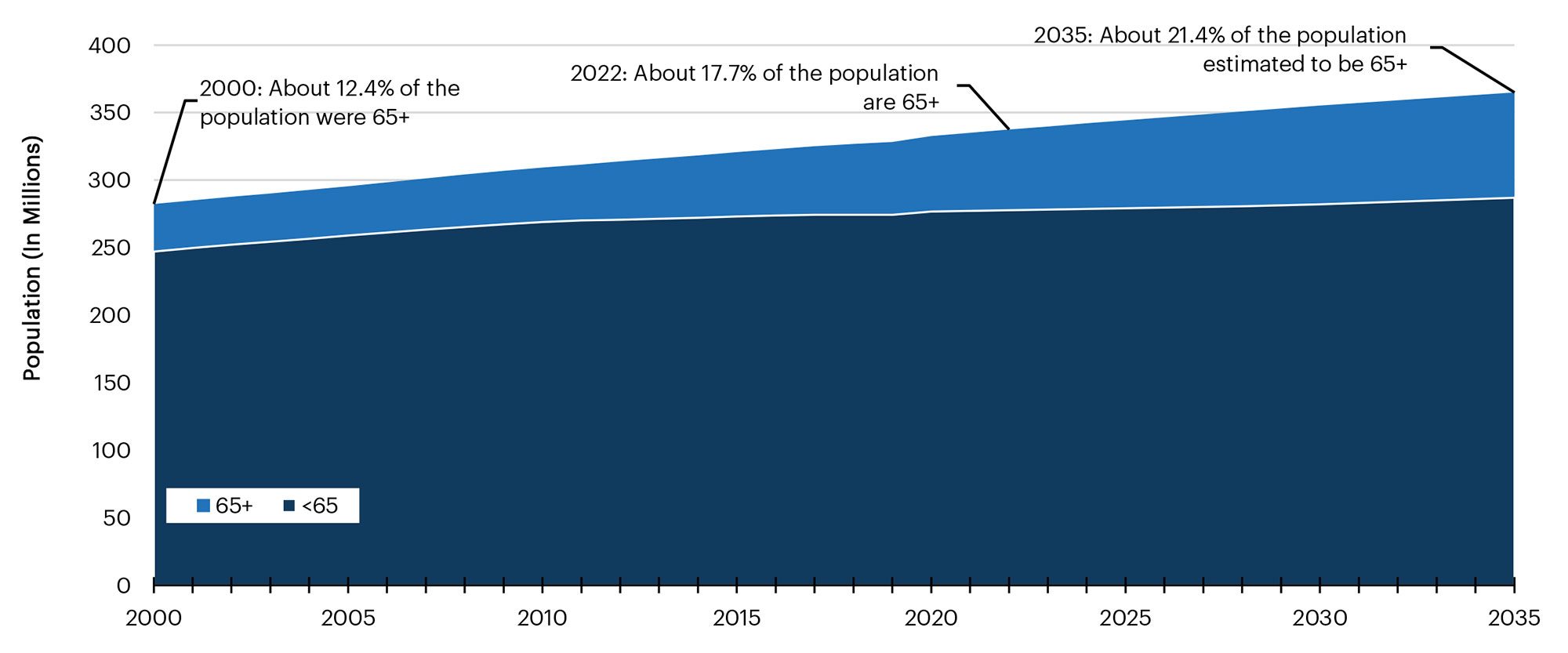
Diversity, Equity, and Inclusion (DEI)
In the shadow of the COVID-19 pandemic, an urgency to address diversity, equity, and inclusion (DEI) has emerged throughout the world. Among this urgency is the need for expanded services for the ever-growing aging population and their needs.
The American Society on Aging (ASA) defines DEI as the following:
Diversity:
The full range of visible and invisible differences that define each of us as human beings.
Equity:
Fair treatment, opportunity, and advancement for all people, while striving to identify and eliminate barriers to such treatment, opportunity, and advancement.
Inclusion:
Systems, structures and processes that promote a sense of belonging, connection, and community where all people feel known, welcomed, and valued.
Traditionally, accommodating aging-related needs has been a largely neglected component of DEI decision-making in many industries. However, airports have begun to update the services and devices needed to assist these passengers and continue to make conscious efforts to accommodate the aging population.
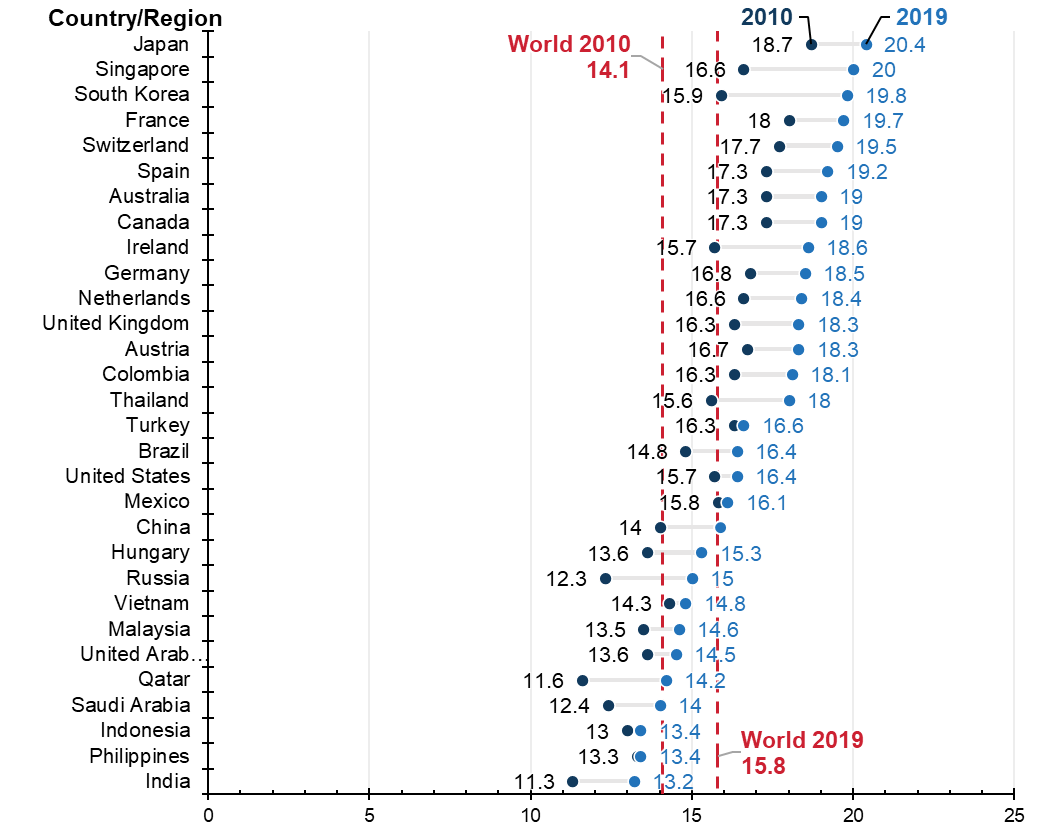
Healthy Life Expectancy At Age 60 Years
Source: World Health Organization, Global Health Observatory Data Repository, Landrum & Brown analysis, 2022
Effects of Air Travel on Aging Population
Some of the key issues confronting aging passengers are mobility issues, chronic diseases, and other impairments such as visual or hearing loss. The most prevalent issues affecting the aging population were identified in ACRP Synthesis 51, Impacts of Aging Travelers on Airports and are identified below:
Wayfinding:
Poses difficulties for passengers in navigating the complex airport environment. Airports are already addressing these issues through changes in font styles and size on signage, as well as utilizing airport volunteer programs to assist passengers with additional needs.
Fatigue:
Widespread issue for aging passengers navigating the airport due to the long exposure to standing, waiting in lines, and walking long distances throughout the airport. Airports are addressing these problems through the use of wheelchairs, people movers, remote bag check-in, handicap accessible devices at passenger service counters, additional/convenient seating, and other services to ease mobility impairments.
Technology:
Grappling with the increasing use of automated systems, self-service machines, Transportation Security Administration (TSA) procedures, and devices used to increase airport efficiency. Baby boomers are more comfortable with technology compared to older generations and this comfortability is only expected to get better in the future. Airports have applauded TSA’s ability to ease the aging population into technology and necessary airport procedures. Some airports received positive feedback from older passengers on their TSA experience and the airport security process.
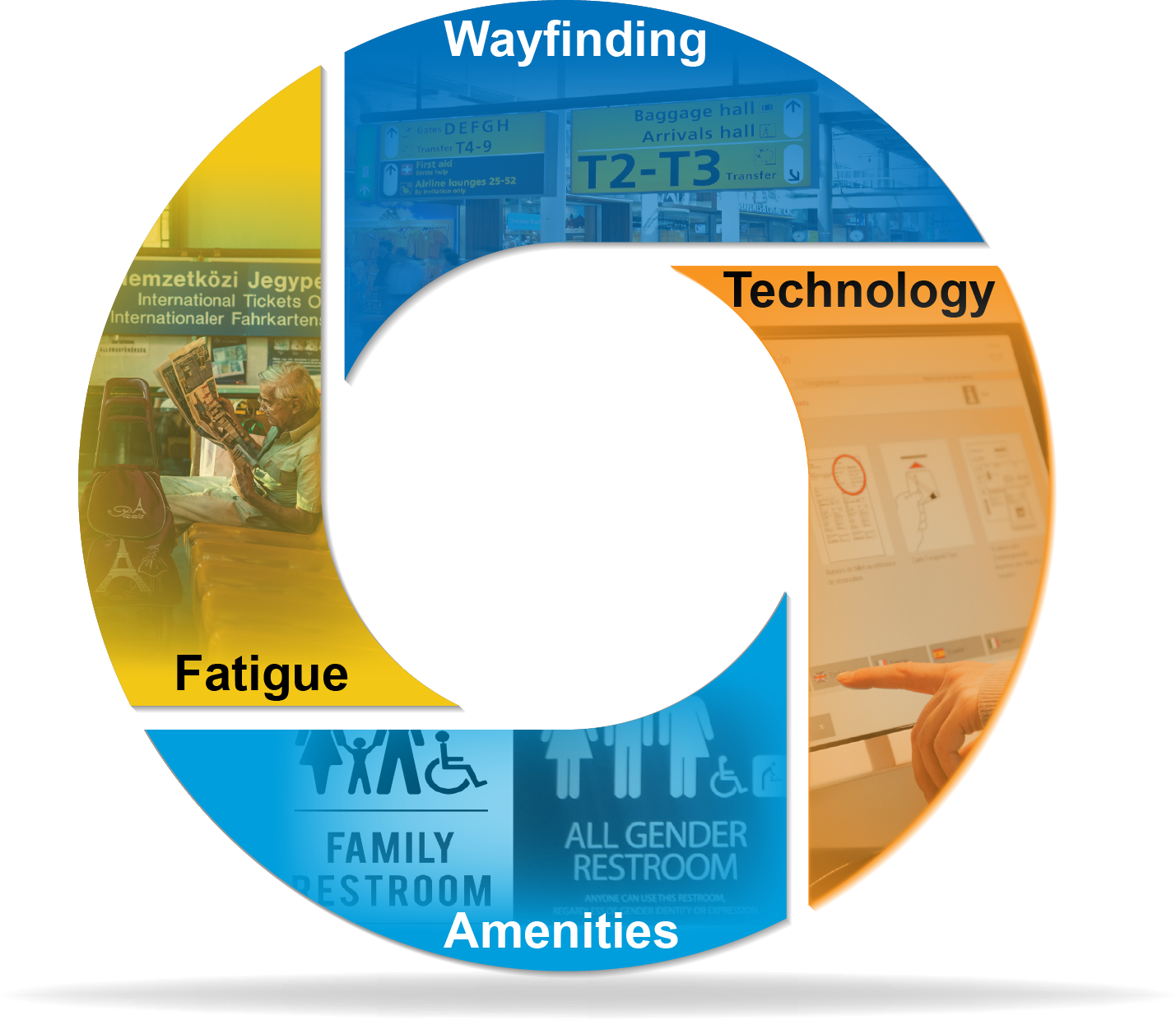
Use of Amenities:
Causes challenges for the aging population due to space limitations in the concession areas and in accessing the restroom facilities. Airports are expected to follow Americans with Disabilities Act (ADA) compliance when designing and constructing facilities in an effort to make terminal facilities more accessible. Airports around the world are adding larger restroom facilities and family restrooms to accommodate individuals who need additional space. Most recently, the Directorate General of Civil Aviation (DGCA) in India has put pressure on airports that have more than 50,000 annual aircraft movements and airlines to ensure that automated buggies are free of charge for passengers needing additional assistance, including aging passengers. This also includes giving them access to luggage trolleys post security.7
U.S. airports pay careful attention to complying with ADA guidelines but are discovering that they need to go above and beyond the minimum requirements to assist this demographic. With aging travelers on the rise, airports and airlines will want to consider responding to the unique needs of this diverse population. A market study released by the Open Doors organization shows that 27 million U.S. travelers with disabilities took a total of 81 million trips and spent $58.7 billion on travel from 2018 to 2019, up from $34.6 billion in the prior 2015 study8 (pre-COVID statistic).
With baby boomers retiring, wheelchairs will continue to become more prevalent at airports. With the increase in needed services also comes the need to provide appropriate staffing for these services. Staffing shortages have impacted airports all over the world and their ability to create an exceptional LOS for persons requiring additional assistance. Since the COVID-19 pandemic started, airports have cross-trained staff in various departments on caring for passengers who require additional assistance. Such staffing shortages have resulted in wheelchair passengers waiting for long periods of time to be transported and some employees pushing multiple wheelchairs while simultaneously moving passengers to their gates in a timely manner.
Not only does this create an unsafe environment for the passengers in wheelchairs but also those around them. In addition to staffing concerns, associated capital and operational costs could hamper an airport’s ability to provide adequate services for passengers needing additional assistance. Airports must begin to update their physical facilities to further accommodate these individuals starting in ground transportation all the way through to the passenger gates. Airports will either need to increase staffing or invest in autonomous devices to assist this influx of passengers and create awareness of the potential operational disruptions as solutions are being implemented.
As the global population continues to age and DEI accommodations become more prevalent, airports and airlines continue to provide accommodations for this demographic and their specific needs. Even though there are a number of required compliance measures enacted by the federal and state governments, many airports are going above and beyond those requirements to enhance passenger experience through DEI and industry efficiency. Some examples include:
- Policy upgrades such as the Hidden Disabilities Sunflower Program (currently growing in industry)
- New technology such as autonomous mobility devices (near-term investments)
- Capital investments such as wheelchair airline seating and restrooms (longer-term investments)
West Virginia International Yeager Airport (CRW), along with many other airports across the U.S., are taking initiative with emerging accommodations for this demographic. With nearly 20% of the West Virginia population over 65 years of age, it is more critical than ever for CRW to address the mobility impairments of those using the Airport. CRW utilizes Spirit Airlines’ manual wheelchair and disabilities training program, participates in the Hidden Disabilities Sunflower Program, and upgraded wayfinding at the airport. In addition, CRW most recently partnered with WHILL to conduct trials with autonomous mobility devices at the Airport.9
Policy: Sunflower Program
The Hidden Disabilities Sunflower Program started at London Gatwick Airport (LGW) back in 2016 when LGW wanted to be more accommodating to people with hidden disabilities. Hidden disabilities includes disabilities that are not as readily apparent. This program voluntarily offers individuals the opportunity to ask for a sunflower lanyard or lapel that can be worn at an airport. This is a subtle but visible way of notifying airport staff to identify that the wearer (or someone with them) may require some extra help, time, or assistance when maneuvering through the airport. Airports and other businesses throughout the world are beginning to implement this program in over 10 different countries including the U.S. So far, over 45 airports across the U.S. offer the Hidden Disabilities Sunflower Program for passengers.10

Source: Hidden Disabilities Sunflower Scheme Limited, 2021
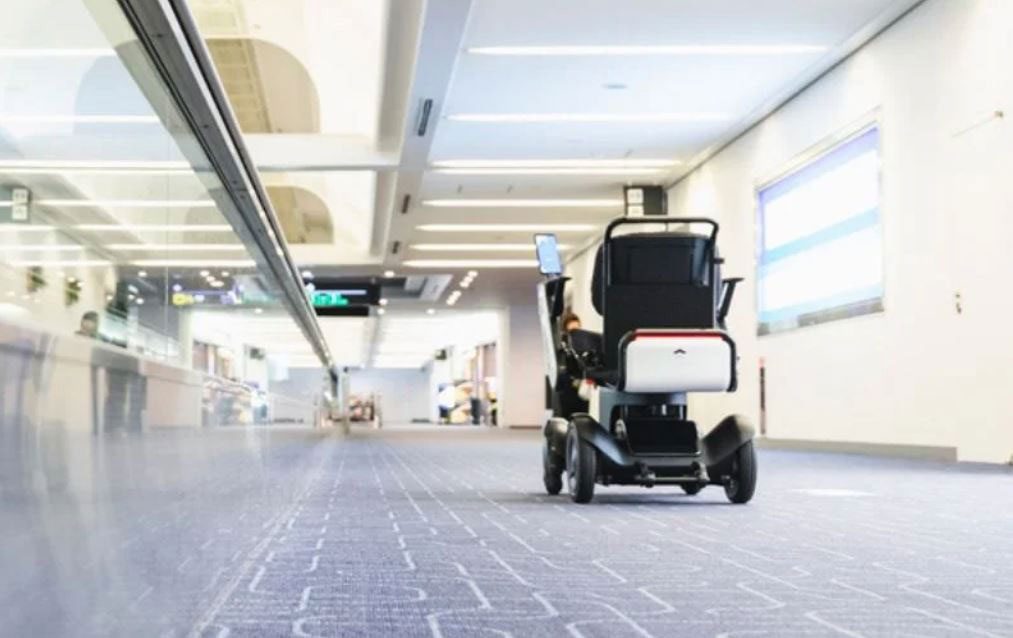
Source: WHILL, 2022.
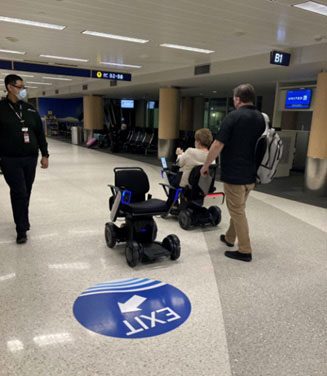
Source: WHILL, 2022.
Technology: Autonomous Mobility Devices
Autonomous devices are becoming more prevalent in the aviation industry including devices that deliver food to airport gates from airport concessionaires (also beneficial to the aging population) and autonomous ground service equipment. Autonomous mobility devices (also known as autonomous wheelchairs) made their debut at Haneda Airport in Tokyo, Japan in 2020. WHILL, a decade old mobility device developer, created the sleek and high-tech device that is now undergoing operational trials at North American airports.11 Trials have also been conducted in Canada, Japan, and United Arab Emirates (UAE).
WHILL, is a modern company that provides people with access to an innovative and well-designed personal mobility solution to ease foot transportation.12 WHILL has found that people with mobility impairments want more independence when it comes to their personal mobility. People do not like being pushed around in a manual wheelchair, often times by an unfamiliar person at airports. Research also indicated the aging population had no problems using the autonomous technology on the mobility device (wheelchair) to get from point to point with a 95% approval rating from trials. Autonomous mobility devices can streamline the transportation of passengers with mobility impairments throughout airports. They could limit the number of staff required, as well as walking distances for staff assisting passengers. Staffers would still need to assist passengers getting into and out of the autonomous chairs and walk passengers through the process on how to use the wheelchair.
Autonomous mobility devices offer passengers independence within the airport, whether it’s taking the passenger to his or her gate or a nearby restroom. The device provides cameras and sensors to detect obstacles and is equipped with audio to alert foot traffic in the vicinity. Once a passenger is at their gate, the wheelchair returns to its “home” for the next user.
Capital Investment/Transformational: Wheelchair Airline Seating & Restrooms
Accessibility is a hot topic throughout airports; however, passengers also experience difficulties on-board the aircraft. To ensure they have adequate time and space to be seated, passengers needing additional mobility assistance often board the aircraft first and then exit last. At airports with greater numbers of mobility impaired passengers, this can take a significant amount of time and manpower to transfer these passengers to and from the aircraft.
Passengers in the travel industry with wheelchairs are a billion-dollar industry that are more readily accommodated by buses and trains, while largely overlooked by the airline industry.13 Aircraft are not easily equipped to handle accessibility needs for mobility impaired individuals, whether it is seating or restroom facilities. Overall, the status quo of aircraft configurations have largely stayed the same, in terms of seating configuration and accommodations, for mobility impaired individuals since the beginning of passenger flight.
New seating has been designed to accommodate mobility impaired individuals; specifically, those in wheelchairs. The new prototype being tested right now is known as the “Freedom Seat”. The Freedom Seat offers passengers the ability to sit in their own wheelchair during flights. The Freedom Seat involves a wider economy aisle seat that slides over the neighboring window seat to leave an open space for a wheelchair to securely lock into place on the floor. The wheelchair would be the first Federal Aviation Administration (FAA) approved wheelchair, which would include specifications to meet locking mechanism devices on aircraft and include an FAA approved restraining system for passenger safety.13
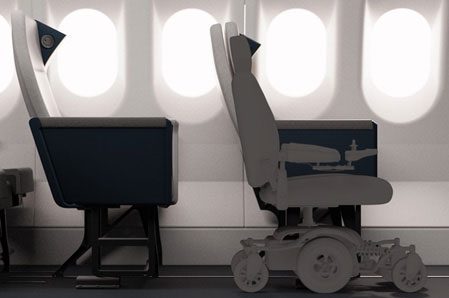
Rendering of the “Freedom Seat” prototype enabling wheelchair use in-flight. Hank Scott/JPA Design / Molon Labe Seating
Source: Molon Labe Seating and JPA Design
The other major mobility problem on-board aircraft are the restrooms. In early 2022, the United States Department of Transportation (USDOT) proposed that airlines make restrooms more accessible for mobility impaired individuals on narrow body aircraft. The 2022 proposal to accommodate handicap restroom facilities on board aircraft outlines two proposals. The first proposal would require new accessibility features, which includes more amenities for the mobility impaired but not full ADA accessibility features to aircraft restrooms. The second proposal is for fully accessible restrooms (ADA compliance) on board commercial aircraft in the US, and would not be required of new aircraft for 20 years.14 Prior to this, a rule was passed in 2016 requiring aircraft with more than 125 seats to have more accessibility for people using on-board wheelchairs and toilets with handles and controls for mobility impaired individuals. Even before that, in 1992 regulators required airlines to have at least one accessible toilet for the mobility impaired on wide body aircraft.15
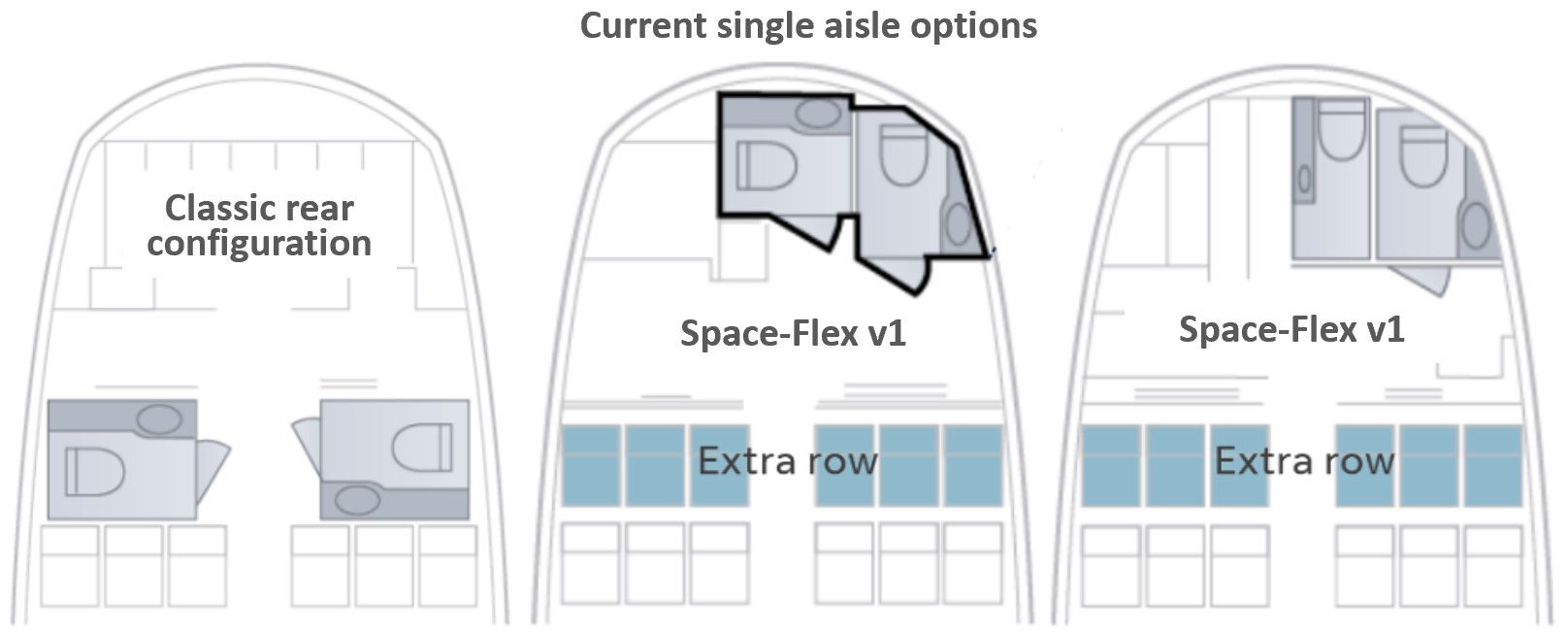
Source: Jennifer F. A. Borrensen, USA Today Network; Airbus, Boeing, and 2016 Access Advisory Committee
Even with minor changes made in last 30 years, Airlines have been excused from complying with the ADA (since 1990) requirements on aircraft unlike the train and bus industries. Less than 5% of single-aisle passenger aircraft in the U.S. have bathrooms large enough for on-board wheelchair use.16 Today, domestic flights primarily use narrow-body aircraft with a single-aisle configuration, which are not required to have bathrooms accessible to people with mobility impairments.
Both Boeing and Airbus offer two new configurations called Space-Flex (1 and 2) offering more accessible restroom configurations. Frontier Airlines is one airline implementing these new Space-Flex restrooms in their new aircraft deliveries. However, not all airlines are opting for these configurations nor are these configurations 100% ADA accessible to all wheelchairs and individuals with disabilities.
Between wheelchair seating accommodations and restrooms aboard U.S. airline aircraft, there are a number of advancements available for governmental approval and acceptance by airlines; however, these accommodations are not expected to be available to baby boomers in their time.
As the number of people over the age of 65 traveling for leisure, medical tourism, and even business increases, airports will need to continue to strive to meet the unique needs of this demographic in the years to come. These passengers will continue to impact airports and the airlines due to their navigational complexity. Airports have started to take the initiative to not just meet government standards but also exceed these standards in order to establish an equitable and inclusive environment that encourages repeat customers.
1 Generation West Virginia, February 2022.
2 Ageing and Health, World Health Organization (WHO), October 2021.
3 Richard Fry, Pew Research Center, April 2020
4 Joseph Chamie, The Hill, April 2021.
5 World Health Organization, Global Health Observatory Data Repository,2022
6 Baby Boomers – Unprecedented Global Issue.” Medical Tourism Magazine, 2022; https://www.magazine.medicaltourism.com/article/baby-boomers-unprecedented-global-issue
7 Sinha, Saurabh, The Times of India, TOI, August 6, 2019; https://timesofindia.indiatimes.com/business/india-business/improve-passenger-experience-at-airports-for-senior-citizens-first-time-flyers-dgca-to-airlines/articleshow/70558757.cms
8 Open Doors Organization, 2020 Market Study https://opendoorsnfp.org/market-studies/2020-market-study/
9 Kevin Price, Chief Development Officer Central West Virginia Regional Airport Authority, 2022.
10 Where Is the Hidden Disabilities Sunflower Recognized, Hidden Disabilities Sunflower Program 2021; https://hiddendisabilitiesstore.com/us/find-the-sunflower
11 Megan Scudellari, IEEE Spectrum; Volume 54, Issue 10, October 2017; https://ieeexplore.ieee.org/abstract/document/8048827
12 WHILL Inc, 2022; https://whill.inc/gb/ and Shannon Fain, Director of Business Development MaaS North America Group, WHILL Inc., 2022.
13 Ruthy Muñoz, Skift, April 2021; https://skift.com/2021/04/08/new-wheelchair-prototype-seat-promises-accessibility-for-in-flight-travel/
14 Jayme Fraser, USA Today Network, 2020; https://stories.usatodaynetwork.com/flying-while-disabled/bathroom-accessibility/
15 George Sensalis, Reduced Mobility Rights Limited (RMR), April 5, 2022; https://www.reducedmobility.eu/20220405745/TheNews/accessible-toilets-on-airplanes-in-america
16 Jayme Fraser, USA Today Network, 2020; https://stories.usatodaynetwork.com/flying-while-disabled/bathroom-accessibility/
What is the L&B LAB?
The LAB is Landrum & Brown’s research and development unit. Our mission is to harness decades worth of industry knowledge and expertise to develop innovative solutions that support our clients along with promoting industry thought leadership.
This document was prepared by Landrum & Brown, Inc. | [email protected]
Sign up to receive our next L&B LAB in your inbox!




